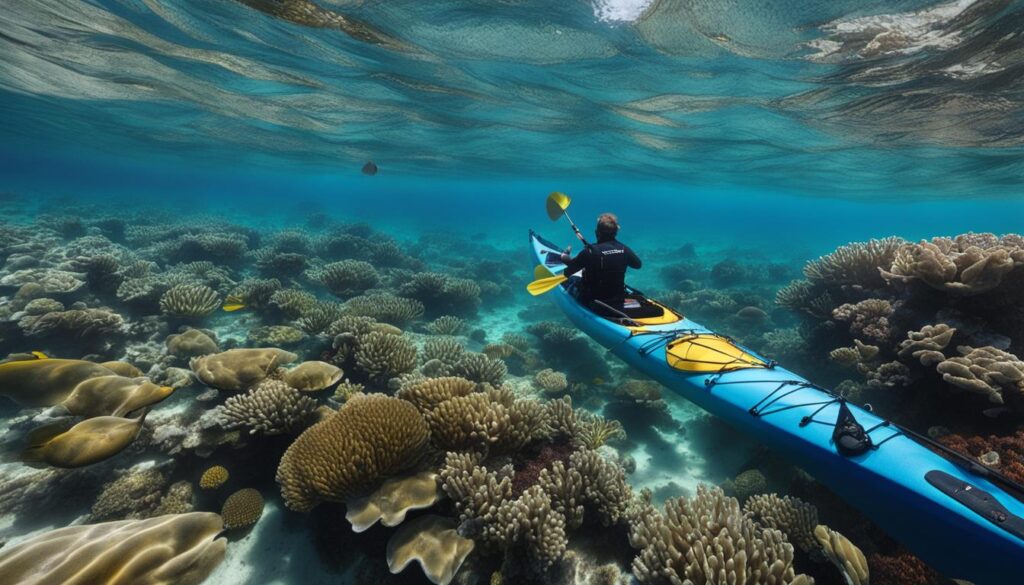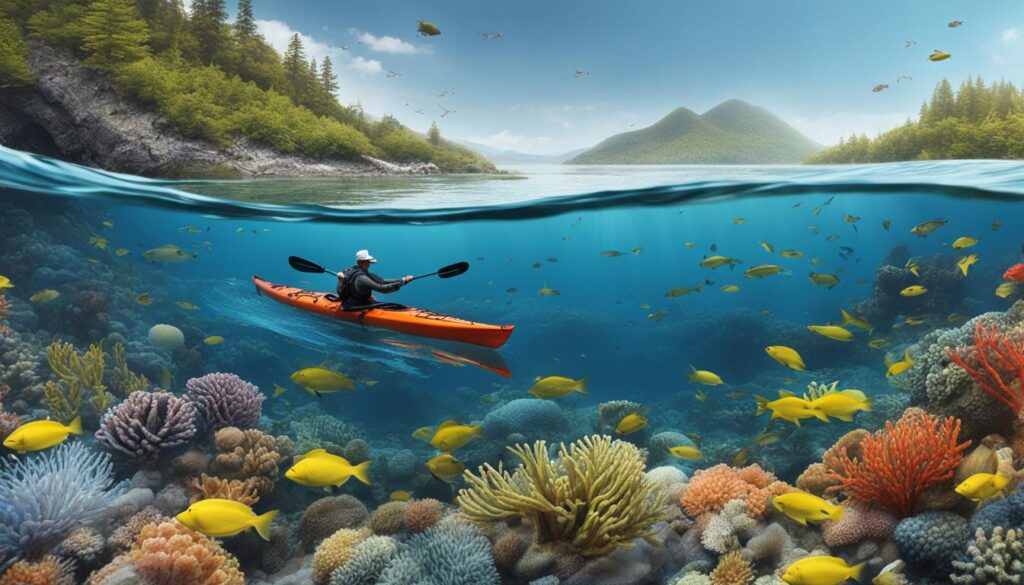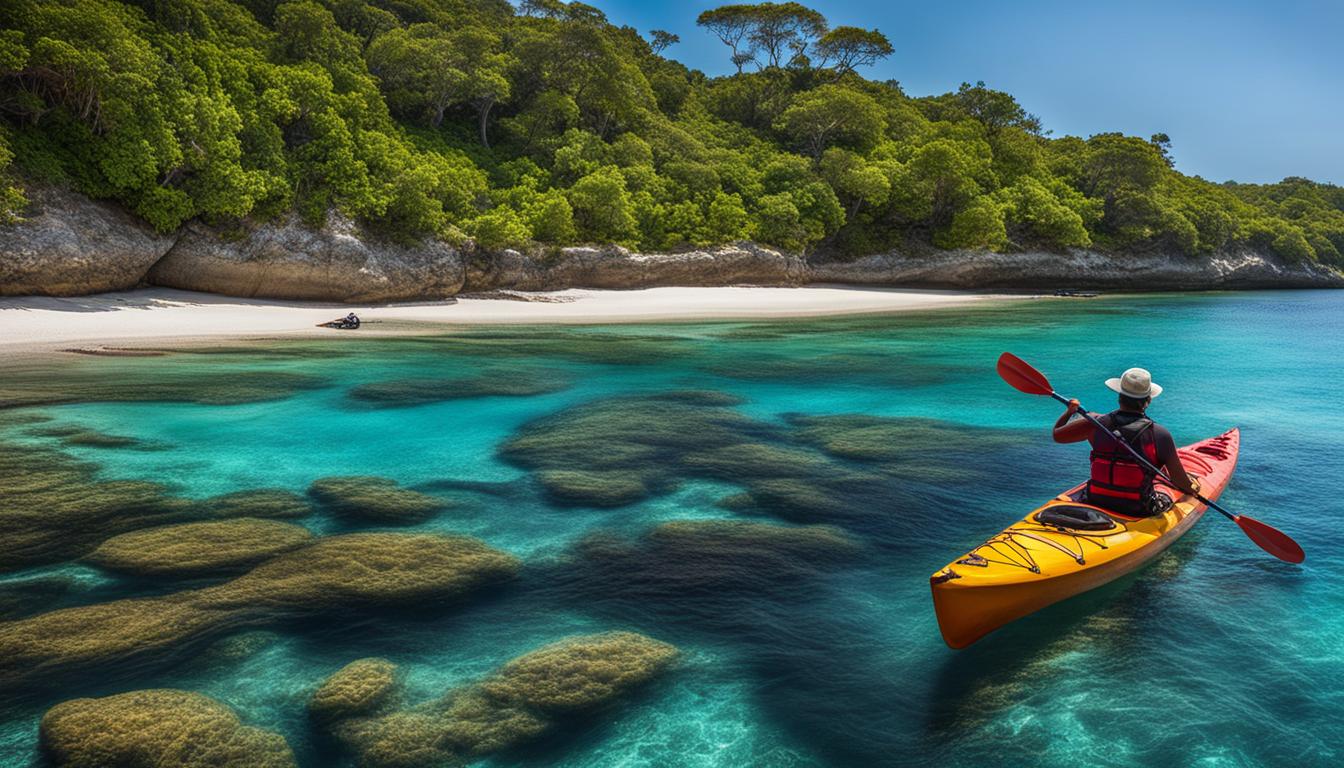Sea kayaking is a popular activity that allows you to connect with nature and explore the beauty of our waterways. However, it’s important to be mindful of the environmental impact and take steps to ensure that your kayaking adventures are eco-friendly and sustainable.
By adopting eco-friendly practices, you can enjoy your sea kayaking experience while preserving the natural beauty of the marine environments. From planning your trip to practicing proper waste management, every decision you make can make a difference.
Key Takeaways:
- Choose landing and camping sites carefully to minimize your impact on marine habitats
- Prevent the transportation of pest species by cleaning your equipment and washing away mud or plant fragments
- Reduce waste and practice proper sanitation by disposing of rubbish responsibly and using designated toilet locations
- Fish responsibly by adhering to fishing regulations and only taking what you need
- Consider going on off-peak journeys and being considerate of wildlife and local communities
Plan Your Route and Choose Landing and Camping Sites Carefully
Before embarking on your sea kayaking adventure, take the time to plan your route and carefully select your landing and camping sites. This is an essential step in minimizing your impact on the marine environment and protecting the natural habitats that you encounter along the way.
When planning your route, consider any sensitive areas or protected zones that you should avoid. These areas may be breeding grounds for marine life or have fragile ecosystems that can be easily disrupted. By steering clear of these areas, you can help preserve the delicate balance of marine environments and prevent any potential harm to vulnerable species.
When it comes to choosing landing and camping sites, be mindful of the impact you may have on the surrounding environment. Look for existing campsites and tracks to minimize your presence and avoid trampling on sensitive vegetation. By doing so, you are helping to maintain the natural beauty and biodiversity of the area.
Additionally, packing appropriate equipment, such as a fuel stove, can help reduce reliance on the environment for resources. This ensures that you leave minimal trace behind and have a smaller impact on the marine ecosystems you are exploring. Remember, every small action counts in protecting the marine environments and minimizing the impact of kayaking.
Avoid Transporting Pest Species
When embarking on a sea kayaking adventure, it’s essential to be mindful of the potential environmental impacts and take steps to protect marine habitats. One important consideration is to avoid unintentionally transporting plant and animal pest species that can disrupt the delicate balance of ecosystems. By implementing simple practices, you can minimize the risk of spreading these species and contribute to the preservation of natural habitats and native flora and fauna.
To prevent the spread of pest species while sea kayaking, it’s crucial to be proactive in cleaning and maintaining your equipment. Before and after each trip, make sure to wash away any soil from pegs and boots to remove potential hitchhikers. Additionally, clean your kayak thoroughly to eliminate any mud or plant fragments that may be clinging to its hull.

By diligently following these cleaning practices, you can significantly reduce the chances of unintentionally introducing invasive species to new environments. This not only helps to protect the biodiversity of marine ecosystems but also safeguards the livelihoods of local communities who depend on these habitats.
Table: Examples of Pest Species and Their Impacts
| Pest Species | Environmental Impact |
|---|---|
| Zebra Mussels | Can clog water intake pipes, damage infrastructure, and outcompete native species for resources. |
| Didymo (Rock Snot) | Can smother riverbeds, alter food webs, and negatively impact fish and invertebrate populations. |
| Asian Carp | Can outcompete native fish, degrade habitats, and disrupt aquatic food chains. |
| Black Rat | Known to prey on native birds and reptiles, threatening their populations and disrupting ecosystems. |
Source: National Park Service
By taking proactive measures to prevent the unintentional transport of pest species, sea kayakers can demonstrate their commitment to eco-consciousness and contribute to the protection of marine environments. Let’s paddle responsibly, preserving the natural beauty of our waterways for future generations to enjoy.
Reduce Waste and Practice Proper Sanitation
Reducing waste and practicing proper sanitation are crucial in minimizing the environmental impact of kayaking. By being conscious of your waste and adopting responsible practices, you can contribute to the conservation of natural areas and prevent pollution. Here are some tips to help you kayak with environmental awareness:
- Take home all your rubbish and leave no trace behind. This means packing out all your trash, including food wrappers, plastic bottles, and any other waste you generate during your kayaking trip.
- Dispose of waste properly. If there are designated waste disposal areas, use them. If not, bury your waste in designated spots away from water sources and campsites. Make sure to dig a hole that is at least six to eight inches deep and cover it properly to prevent animals from digging it up.
- Research toilet locations before your trip. If there are toilets available along your route, use them instead of going in the wild. This helps prevent waste from contaminating sensitive ecosystems and water sources.
- Practice good hygiene. Wash your hands thoroughly with biodegradable soap after using the toilet or before handling food. This helps prevent the spread of bacteria and protects the waterways.
By following these practices, you can minimize the impact of waste and sanitation while enjoying your kayaking adventure in an environmentally responsible way.
Quote:
“The beauty of kayaking lies in the harmony between humans and nature. By practicing proper waste management and sanitation, kayakers can actively contribute to the preservation of our waterways.” – Environmental Kayaking Association
Table: Waste Disposal Methods
| Method | Description |
|---|---|
| Burying | Dig a hole and bury your waste at least six to eight inches deep, away from water sources and campsites. |
| Pack Out | Bring all your trash with you and dispose of it properly in designated waste receptacles. |
| Use Toilets | If available, use designated toilets along your kayaking route to prevent waste contamination. |
| Biodegradable Soap | Use biodegradable soap to wash your hands and dishes to minimize the environmental impact of detergents. |
Sustainable Fishing Practices for Responsible Sea Kayaking
When engaging in sea kayaking, it is important to practice sustainable fishing to ensure the long-term viability of marine ecosystems. By adopting responsible fishing practices, you can minimize your impact on fish populations and contribute to the conservation of our waterways. Here are some key guidelines to follow:
- Obtain the necessary fishing licenses and adhere to local regulations. This helps to ensure that you are fishing within legal limits and not depleting vulnerable fish populations.
- Respect “no-take” zones and protected areas, as they play a crucial role in the preservation of marine habitats.
- Practice selective fishing by only targeting the species you need and avoiding undersized fish. This helps to maintain the balance of the ecosystem and allows fish populations to replenish.
- Use appropriate fishing gear and techniques that minimize unintended harm to non-target species. For example, consider using circle hooks, which reduce the likelihood of catching and injuring non-target fish.
By incorporating these sustainable fishing practices into your sea kayaking trips, you can enjoy the benefits of fishing while actively contributing to the conservation efforts of our waterways.
Remember, sustainable fishing is not only about catching fish—it’s about preserving the delicate balance of marine ecosystems and ensuring the future availability of fish for everyone to enjoy.
Now let’s take a look at a table comparing sustainable fishing practices:
Fishing Practices Comparison
| Practice | Benefits | Considerations |
|---|---|---|
| Obtain fishing licenses | Contributes to the management of fish populations | Check local regulations and stay up to date with fishing license requirements |
| Respect “no-take” zones | Preserves important breeding and feeding grounds | Research and familiarize yourself with the designated “no-take” zones in your area |
| Practice selective fishing | Maintains fish populations and allows for sustainable harvesting | Learn about the size and bag limits for different fish species |
| Use appropriate fishing gear | Reduces bycatch and minimizes harm to non-target species | Explore gear options that align with sustainable fishing practices |
By implementing these sustainable fishing practices and being mindful of the impact of your actions, you can contribute to the conservation efforts of our waterways and help ensure that future generations can enjoy the beauty and abundance of marine ecosystems while sea kayaking.

Off-Peak Journeys and Considerate Kayaking
When planning your sea kayaking adventure, consider embarking on off-peak journeys to help protect marine environments. By choosing to explore during quieter seasons, you can minimize the strain on resources and reduce the impact of tourism on natural areas. This allows for a more immersive experience, connecting you with the serene beauty of the waterways while minimizing your ecological footprint.
While on your kayaking trip, it’s important to be considerate of the wildlife and local communities that call these environments home. Maintain a respectful distance from wildlife, avoiding any disturbances to their natural behavior. Additionally, be mindful of breeding and nesting sites, ensuring that you do not cause any unnecessary stress or harm. By observing these guidelines, you can help safeguard the well-being of the flora and fauna in these marine habitats.
Furthermore, it’s crucial to practice proper food and waste management during your kayaking adventure. Store food securely to prevent attracting wildlife to campsites, and dispose of waste responsibly, following designated guidelines for waste disposal. These measures not only keep the environment clean and free from potential pollutants but also minimize any negative interactions between humans and wildlife. By being considerate and responsible, you can actively contribute to the preservation of both the natural and cultural sites that make sea kayaking such a rewarding experience.
Table: Off-Peak Season Recommendations
| Destination | Off-Peak Season |
|---|---|
| Florida Keys, USA | May – November |
| Peloponnese, Greece | September – November |
| Fiordland, New Zealand | March – November |
| Baja California, Mexico | December – March |
By referring to the table above, you can plan your sea kayaking trips to these destinations during the recommended off-peak seasons. This will not only provide you with a serene and uncrowded experience but also contribute to the protection of marine environments in these regions.
Conclusion
Kayaking is a wonderful way to connect with nature and experience the beauty of our waterways. However, it’s important for kayakers to be mindful of their impact on the environment. By adopting environmentally responsible practices, you can contribute to the conservation efforts and ensure the preservation of these natural habitats for generations to come.
Throughout this article, we have discussed the various ways in which you can practice kayaking eco-consciousness. Planning your trips, choosing suitable equipment, and following guidelines for waste management are essential steps to minimize your impact. Being considerate of wildlife and cultural sites is also important in maintaining the delicate balance of our ecosystems.
By incorporating kayaking conservation efforts into your adventures, you not only protect the environment but also encourage sustainable practices. Remember, every action counts. Together, we can enjoy the wonders of sea kayaking while safeguarding the beauty and biodiversity of our marine environments.
FAQ
What are some eco-friendly practices for sea kayaking?
Some eco-friendly practices for sea kayaking include planning your route and choosing landing and camping sites carefully, avoiding the transportation of pest species, reducing waste and practicing proper sanitation, fishing responsibly, and being considerate of wildlife and cultural sites.
How can I minimize my impact on the marine environment while kayaking?
To minimize your impact on the marine environment, it’s important to plan your route and choose landing and camping sites carefully. Additionally, you should avoid transporting pest species, reduce waste and practice proper sanitation, fish responsibly, and be considerate of wildlife and cultural sites.
What can I do to prevent the spread of pest species while kayaking?
To prevent the spread of pest species while kayaking, you can take steps such as washing soil from pegs and boots, cleaning your kayak between trips, and washing away mud or plant fragments.
How should I dispose of waste while kayaking?
When disposing of waste while kayaking, it’s important to pack out all your rubbish and leave no trace behind. Dispose of waste properly by burying it in designated areas away from water sources and campsites or carrying it out of areas where disposal is difficult.
How can I fish responsibly while kayaking?
To fish responsibly while kayaking, obtain appropriate fishing licenses and adhere to “no-take” zones and regulations. Only take the fish you need and ensure they are not undersized.
What are some tips for being considerate while kayaking?
To be considerate while kayaking, choose to go on trips during off-peak seasons to prevent overstraining resources. Also, maintain a respectful distance from wildlife, avoid disturbing breeding sites, and store food and rubbish securely to prevent wildlife from being attracted to campsites. Additionally, respect indigenous sites and adhere to regulations set by local communities and land managers.





